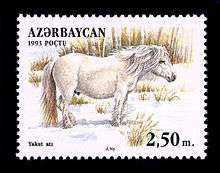Yakutian horse
.jpg) A Yakutian horse | |
| Other names | Yakut |
|---|---|
| Country of origin | Yakutia (Russia) |
| Distribution | Yakutia |
| Traits | |
| Weight |
|
| Height |
|
The Yakutian horse (Sakha: Саха ата, Sakha ata), sometimes called the Yakut horse, Yakut pony or simply the Yakut, is a rare native horse breed from the Siberian Sakha Republic (or Yakutia) region. It is large compared to the otherwise similar Mongolian horse and Przewalski's horse (the former being a breed; the latter the last wild horse in the world).[1] It is noted for its adaptation to the extreme cold climate of Yakutia, including the ability to locate and graze on vegetation that is under deep snow cover,[2] and to survive without shelter in temperatures that reach −70 °C (−94 °F).[3]
The horses appear to have evolved from domesticated horses brought with the Yakuts when they migrated to the area beginning in the 13th century, and are not descended from wild horses known to inhabit the area in Neolithic times.[3]
Varieties and characteristics

The breed averages 140 centimetres (13.3 hands) in stallions and 136 cm (13.2 h) in mares,[4][1] and shares certain outward characteristics with other northern breeds like Shetland pony, Fjord horse and Icelandic horse including sturdy stature, thick mane and heavy hair coat.[3]
There are several subtypes of the Yakutian horse.[5] The Northern type is the purest bred Yakut, and is sometimes called the Middle Kolyma or Verkhoyansk horse. It is usually bay, gray or light dun in color, with primitive markings including a dark dorsal stripe and zebra-pattern stripes on the legs. Stallions measure 139 cm (13.3 h) at withers on average, mares are 137 cm (13.2 h). This variety is considered to be the most valuable. The second variety is the Smaller Southern type, which is also considered a pure but less valuable breed. Average height is 135 cm (13.1 h) in stallions and 132 cm (13.0 h) in mares. The third variety is the Larger Southern type, which is the result of cross-breeding with other breeds, and is widespread in central Yakutia. This type measures 141 cm (14.0 h) in stallions and 136 cm (13.2 h) in mares.[6][1]
Adaption to the Siberian environment
In Siberia, annual temperatures fluctuate between +38 and −70 °C (+100 and −94 °F) and winter may last for 8 months.[5] Yakutian horses are kept unstabled year-round, and in the roughly 800 years that they have been present in Siberia, they have developed a range of remarkable morphologic, metabolic and physiologic adaptions to this harsh environment.
- While smaller than modern highly derived horse breeds, they are larger than other primitive horse breeds (Bergmann’s rule);[1] at the same time they have a compacter build with a stouter trunk and legs that are relatively short in proportion to the horse’s size (Allen’s rule).[3]
- Their winter coat is extremely dense[3] and reaches a hair length of 8 cm (3.1 in).[1]
- Their metabolism adjusts to seasonal needs. In fall they accumulate large fat reserves, in winter the metabolic rate is lowered, and in spring they show an increased carbohydrate metabolism, making use of the freshly sprouting grass.[3]
- They show an increased production of antifreezing compounds.[3]
- They may further avoid frostbite by reducing the volume of circulating blood during times of extreme cold, as indicated by an increased responsiveness of their genetic networks involved in oxidative stress responses, vasodilation, and blood coagulation.[3]
Genetically they show indications of convergent evolution with other inhabitants of the Far North like mammoths regarding their adaption to the extreme cold.[3]
See also
References
- 1 2 3 4 5 Breeds of Livestock - Yakut Horse, Department of Animal Science, Oklahoma State University, retrieved 2009-04-20,
... Compared to horses of similar type and Mongolian origin, the Yakut is larger and more massive. Three Yakut types have been formed: the Northern original Yakut (the Middle Kolyma or Verkhoyansk horse); the smaller southern type which was not crossed with improved breeds; and the larger southern type tending towards the breeds used for the improvement of the local Yakut ...
- ↑ Anatoly Mikhailovich Khazanov (1995), After the USSR: ethnicity, nationalism and politics in the Commonwealth of Independent States, University of Wisconsin Press, ISBN 0-299-14894-7, retrieved 2009-04-20,
... The Yakut horse has the ability to uncover grass that is under as much as 50 centimeters of snow (and the snow cover lasts in the country for seven to eight months a year) ...
- 1 2 3 4 5 6 7 8 9 Librado, Pablo; et al. (23 November 2015). "Tracking the origins of Yakutian horses and the genetic basis for their fast adaptation to subarctic environments". Proceedings of the National Academy of Sciences of the United States of America. 112 (50): E6889–97. doi:10.1073/pnas.1513696112. Lay summary – University of Copenhagen press release (23 November 2015).
contemporary Yakutian horses do not descend from the native horses that populated the region until the mid-Holocene, but were most likely introduced following the migration of the Yakut people a few centuries ago. Thus, they represent one of the fastest cases of adaptation to the extreme temperatures of the Arctic.
Popular science write-ups: siberiantimes.com, bbc.com, equimed.com, phys.org - ↑ Food and Agriculture Organization of the United Nations / Domestic Animal Diversity Information System (DAD-IS): “Yakutskaya/Russian Federation.” Retrieved 11 November 2017.
- 1 2 Alexeev, N.D., N.P. Stepanov [n.d.] “Yakut Horse: Breed Types, Economical and Biological Features.” NGO Sakha – World XXI Century, w/o date. Archived from the original on 13 May 2008. Retrieved 11 November 2017.
- ↑ Bonnie Lou Hendricks (1995), International encyclopedia of horse breeds, University of Oklahoma Press, ISBN 0-8061-2753-8, retrieved 2009-04-20,
... There are three types within the breed; the northern, original Yakut (called the Middle Kolyma or Verkhoyansk horse); the smaller southern type, which has not been crossed with improved breeds; and the larger southern type, which tends toward the breeds used for improvement ...